Introduction
In the realm of data analysis, harnessing the full power of DAX (Data Analysis Expressions) can transform how organizations interpret and utilize their data. Among the myriad of functions available, COUNTROWS and DISTINCTCOUNT stand out as essential tools for any data analyst aiming to derive meaningful insights from complex datasets. Understanding these functions is not just about counting; it’s about unlocking the potential for strategic decision-making and operational efficiency. As businesses increasingly integrate DAX with Robotic Process Automation (RPA), the ability to automate data tasks and streamline workflows becomes crucial. This article delves into the intricacies of COUNTROWS and DISTINCTCOUNT, offering practical examples and strategies that empower analysts to enhance their data capabilities and drive growth in their organizations.
Understanding DAX Functions: COUNTROWS and DISTINCTCOUNT
DAX (Data Analysis Expressions) serves as a powerful formula language integral to Power BI, Excel, and other Microsoft applications, playing a crucial role in Business Intelligence and driving operational efficiency. Among its primary roles, COUNTROWS and the dax distinctcount with filter function are vital instruments for any analyst aiming to unlock the potential of their datasets.
- COUNTROWS counts the total number of rows within a table or table expression, making it invaluable for assessing the volume of entries present in a dataset.
This method is especially beneficial for rapidly assessing the volume of your information pool, directing later analysis and facilitating more efficient reporting. For example, in a recent case study, the SUM operation aggregates values in a column while SUMX assesses an expression for each row before summing results, illustrating how COUNTROWS complements these calculations by providing a clear count of total entries.
- Conversely, the function known as dax distinctcount with filter emphasizes counting unique values within a specified column, which is essential for comprehending variety, such as recognizing unique customer segments or product types. As emphasized by recent statistics, the utilization of DAX capabilities has surged in 2024, reflecting their increasing significance in successful information analysis practices.
Understanding these capabilities is essential for utilizing DAX effectively, especially when applying dax distinctcount with filter to extract specific insights. By integrating DAX with RPA solutions, organizations can automate repetitive data tasks, thus reducing the time-consuming nature of report creation and minimizing data inconsistencies. Mastering tools such as COUNTROWS and unique counts will empower you to make informed decisions, enhance your analytical capabilities, and ultimately drive growth and innovation in your organization.
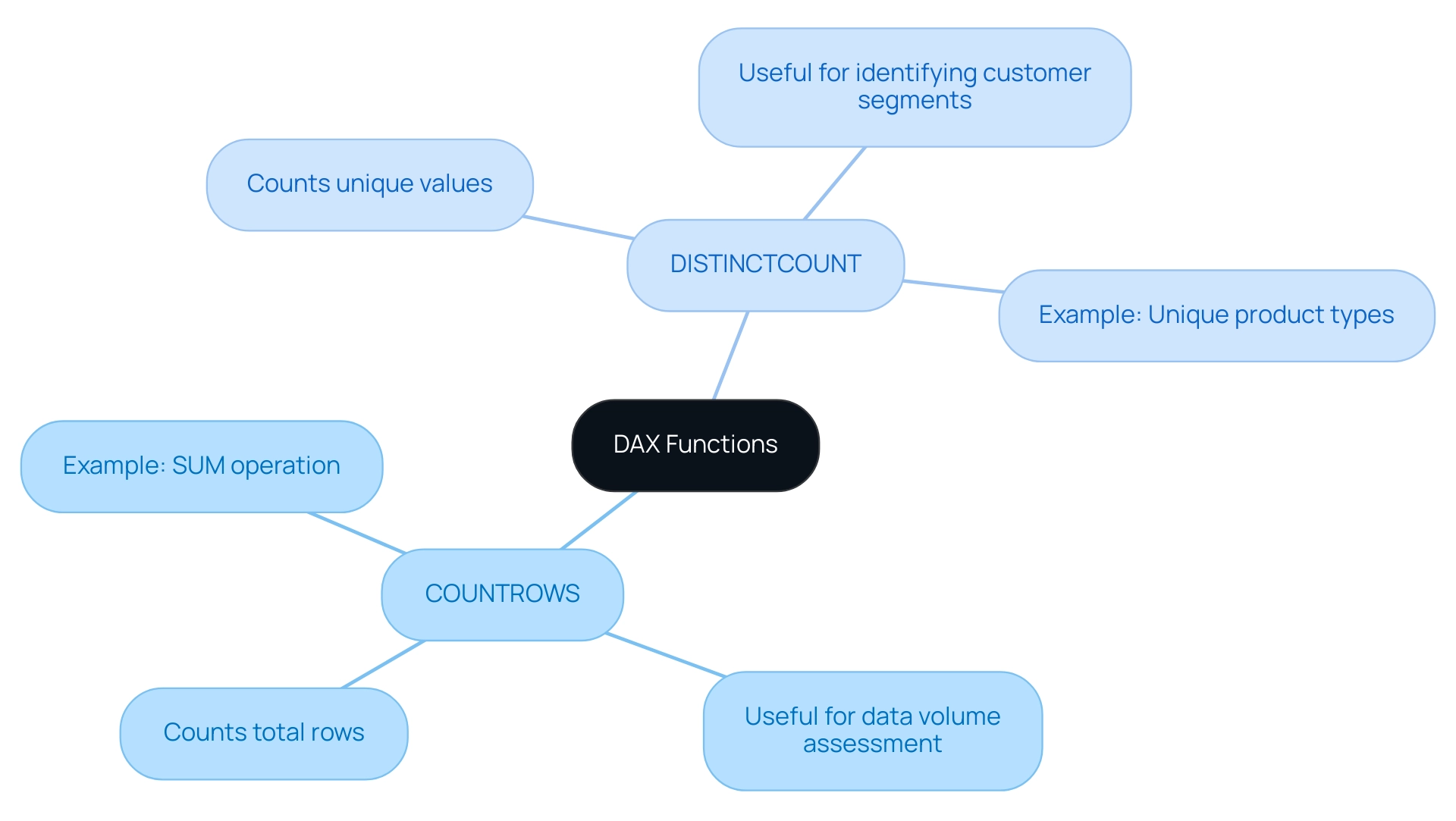
Syntax Breakdown of DISTINCTCOUNT in DAX
The DAX DISTINCTCOUNT with filter formula is a powerful tool for counting unique values within a specified column, which is essential for enhancing Business Intelligence capabilities and driving operational efficiency through RPA. The syntax for this function is straightforward:
DISTINCTCOUNT(columnName)
- columnName: This refers to the specific column from which distinct values will be counted. It is essential that this column is incorporated into a well-organized information model, ensuring precise calculations.
For instance, consider a table labeled ‘Sales’ where you aim to determine the number of distinct customers. Your DAX formula would be:
DISTINCTCOUNT(Sales[CustomerID])
Understanding this syntax is crucial as it lays the groundwork for implementing filters and developing more complex DAX expressions. Mastery of COUNT UNIQUE not only enhances your analytical capabilities but also streamlines information processes, reducing repetitive tasks and addressing outdated systems, positioning you as a key player in your organization, refining strategies based on diverse consumer interactions.
As pointed out by expert Glenn Seibert, with 209 shops in North America, the capability to precisely tally unique values can greatly affect business choices across different locations. Furthermore, utilizing dax distinctcount with filter assists in overcoming typical obstacles encountered when deriving insights from Power BI dashboards, such as inconsistencies in information and the lengthy process of report generation. Engaging in courses such as the ‘Power BI Advanced Topics Course’ can provide professionals with the skills needed to use techniques effectively, resulting in valuable outcomes and enhanced operational efficiency.
It is also crucial to be aware that some DAX operations can be volatile, returning different results with the same arguments, highlighting the importance of understanding DAX nuances in practical applications.
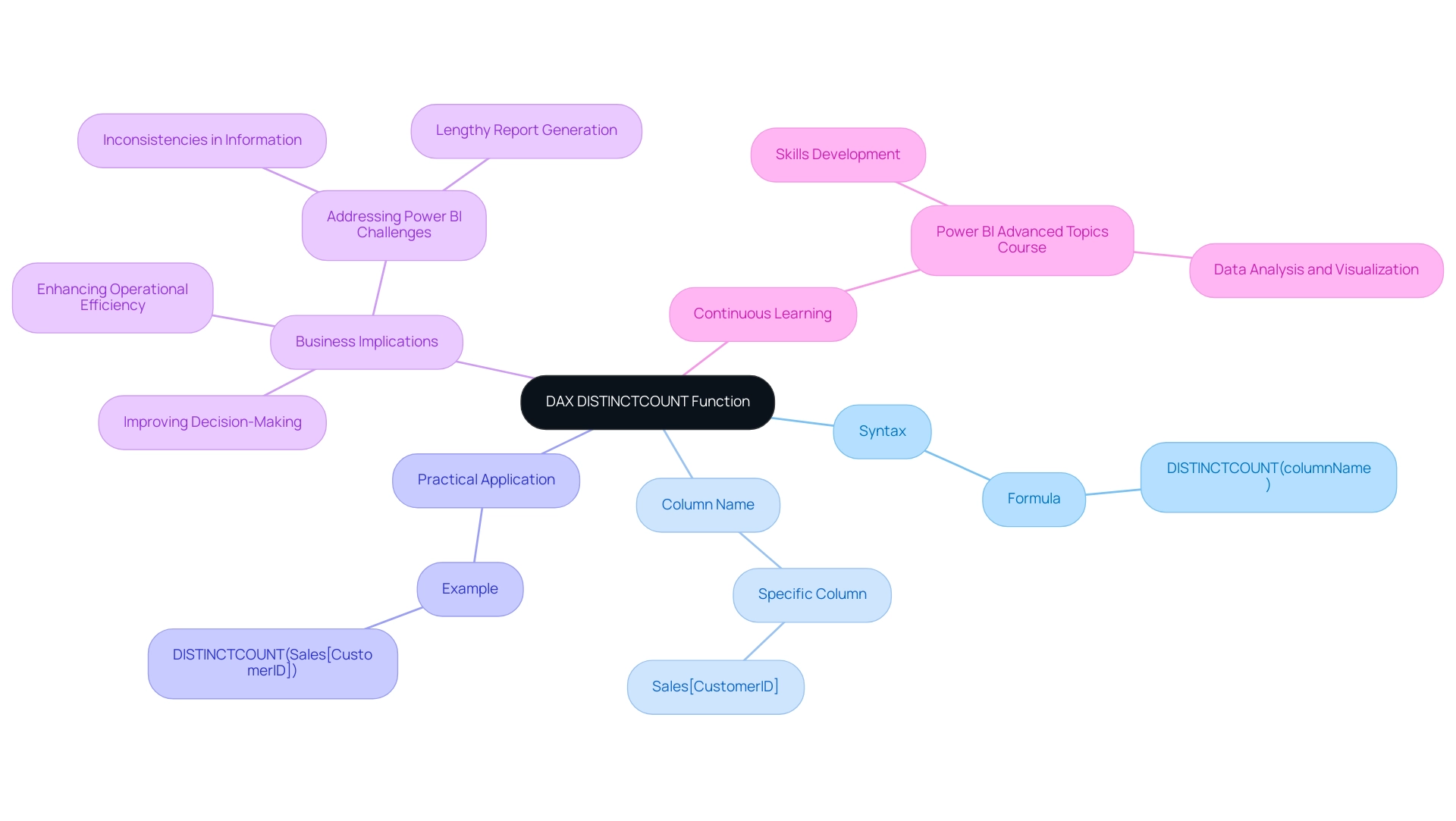
Practical Examples of DISTINCTCOUNT Usage
Applying the DAX distinctcount with filter feature can greatly enhance your analysis capabilities, especially as the market for information quality tools is expanding at 16% each year. This process is an essential component in overcoming technology implementation challenges, particularly in enhancing operational efficiency through accurate data management. Furthermore, when combined with Robotic Process Automation (RPA), the use of DAX functions can streamline workflows, reduce manual tasks, and free up your team for more strategic, value-adding work.
Here are several practical examples to illustrate its effectiveness:
-
Counting Unique Products Sold: To determine the number of unique products sold during a specific period, utilize the following DAX formula:
DAX
DISTINCTCOUNT(Sales[ProductID])
This calculation is crucial as the retail market for unique product sales is projected to grow significantly, emphasizing the importance of accurate inventory analysis in 2024. Furthermore, utilizing unique count helps avoid duplicate entries in your summary index, ensuring the integrity of your data and freeing up resources for more strategic efforts. -
Finding Unique Customers: To assess how many distinct customers made purchases, the following formula is effective:
DAX
DISTINCTCOUNT(Sales[CustomerID])
Understanding your customer base is vital for retention strategies, as highlighted by Databel’s upcoming analysis of customer usage patterns and competitor comparisons. This method also aids in preventing duplicate entries, which can skew your understanding of customer dynamics, thus enhancing your overall operational efficiency. Integrating tailored AI solutions can further refine this analysis, providing deeper insights into customer behaviors. -
Evaluating Unique Transactions: To count the number of distinct transactions, you can apply:
DAX
DISTINCTCOUNT(Sales[TransactionID])
This metric is essential for evaluating sales performance and identifying trends over time. As noted by industry expert Anna Dunay, effective information management strategies, including the reuse of components and avoiding duplicates, can lead to improved product quality without compromising overall outcomes. By utilizing RPA together with DAX functions, companies can streamline the information gathering process, ensuring that these metrics remain consistently current and precise.
These illustrations clearly showcase the usefulness of COUNT across different contexts, providing you with practical tools to enhance the effectiveness and precision of your datasets. Leveraging such Business Intelligence tools, along with RPA and AI solutions, can transform raw data into actionable insights, enabling informed decision-making that drives growth and innovation.
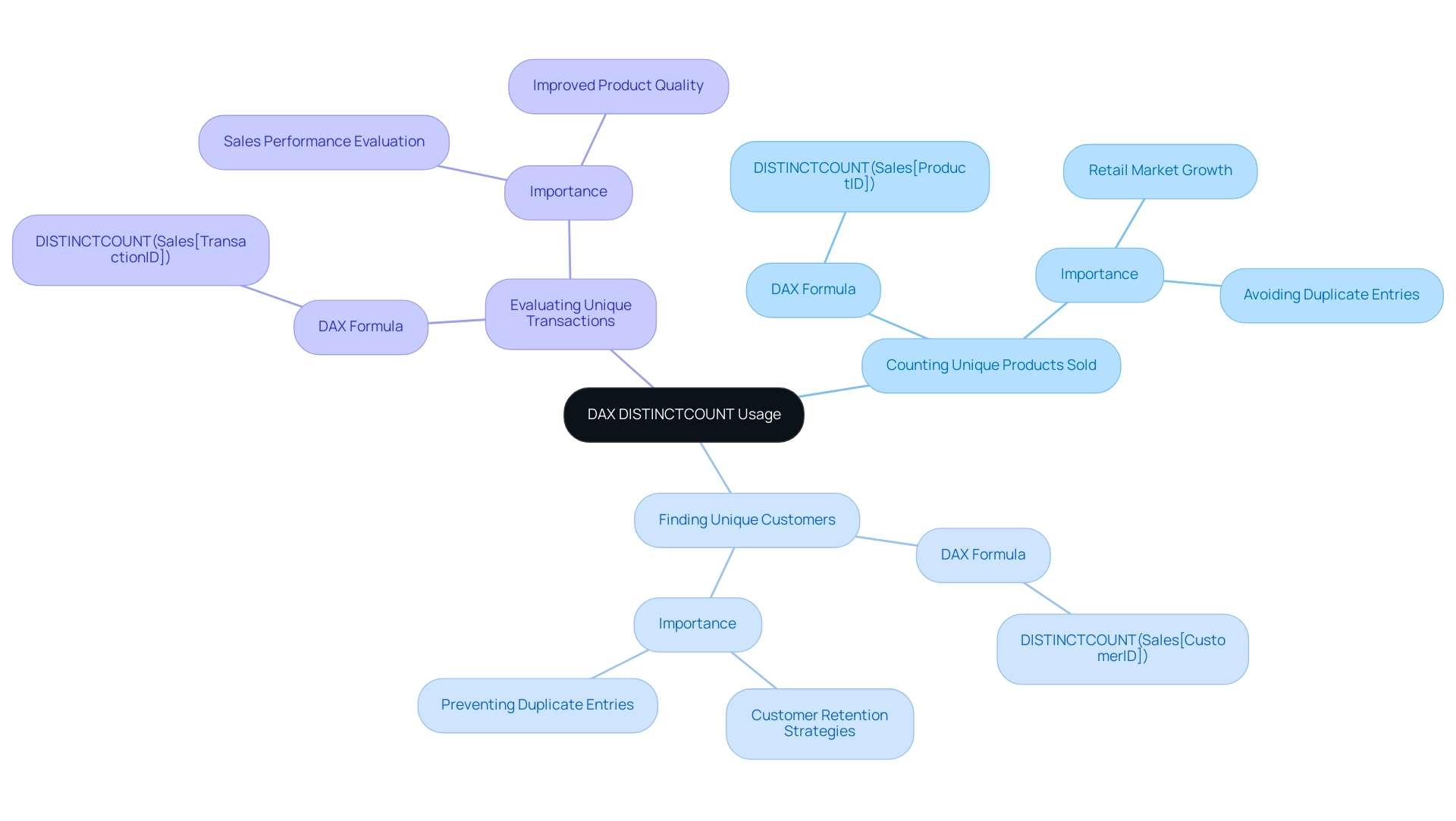
Applying Filters with DISTINCTCOUNT: A Step-by-Step Approach
To effectively apply filters with DISTINCTCOUNT in DAX while leveraging Robotic Process Automation (RPA) to enhance operational efficiency, follow these actionable steps:
- Define Your Filter: Begin by establishing the criteria for your filter. For instance, if your goal is to count unique customers who made purchases in a specific year, your filter criteria will focus on that specific year. You can utilize the
ENDOFYEAR(<dates>)method to dynamically reference the end of the year, ensuring your analysis remains relevant.
To analyze the data effectively, we can use DAX DISTINCTCOUNT with FILTER. Write the DAX expression that utilizes DAX DISTINCTCOUNT with FILTER to combine the unique count function with the FILTER function. Here’s a practical example:
DISTINCTCOUNT(FILTER(Sales, Sales[Year] = <specific_year>), Sales[CustomerID])
-
Automate Tasks: Consider automating manual activities related to your DAX processes, such as entry, report generation, or cleaning, using RPA. This can significantly reduce errors and save time, allowing your team to focus on strategic insights.
-
Test Your Formula: Once your DAX expression is written, test it within your model to verify that it yields the expected results. Make adjustments to your filter criteria as needed to refine your analysis. By automating this process with RPA, you can further enhance accuracy and efficiency.
-
Analyze Results: Leverage the output to extract meaningful insights from your information. For example, understanding customer behavior in a specific year can significantly enhance your marketing strategies. RPA can assist by automating the collection and reporting processes, facilitating quicker access to actionable insights.
This systematic method not only enables you to incorporate filters with UNIQUECOUNT effectively but also improves your overall analysis capabilities. As Joleen Bothma states, “Discover how to make your Power BI reports more insightful, informative, and interactive with this advanced analytical features tutorial.” For further insights, consider exploring her advanced tutorial on analytical features in Power BI, which can elevate your reporting to new levels of interactivity and insight.
Additionally, the case study titled ‘Advanced Analytical Features in Power BI Tutorial’ illustrates how users have successfully enhanced their reports with advanced features, increasing interactivity and insight.
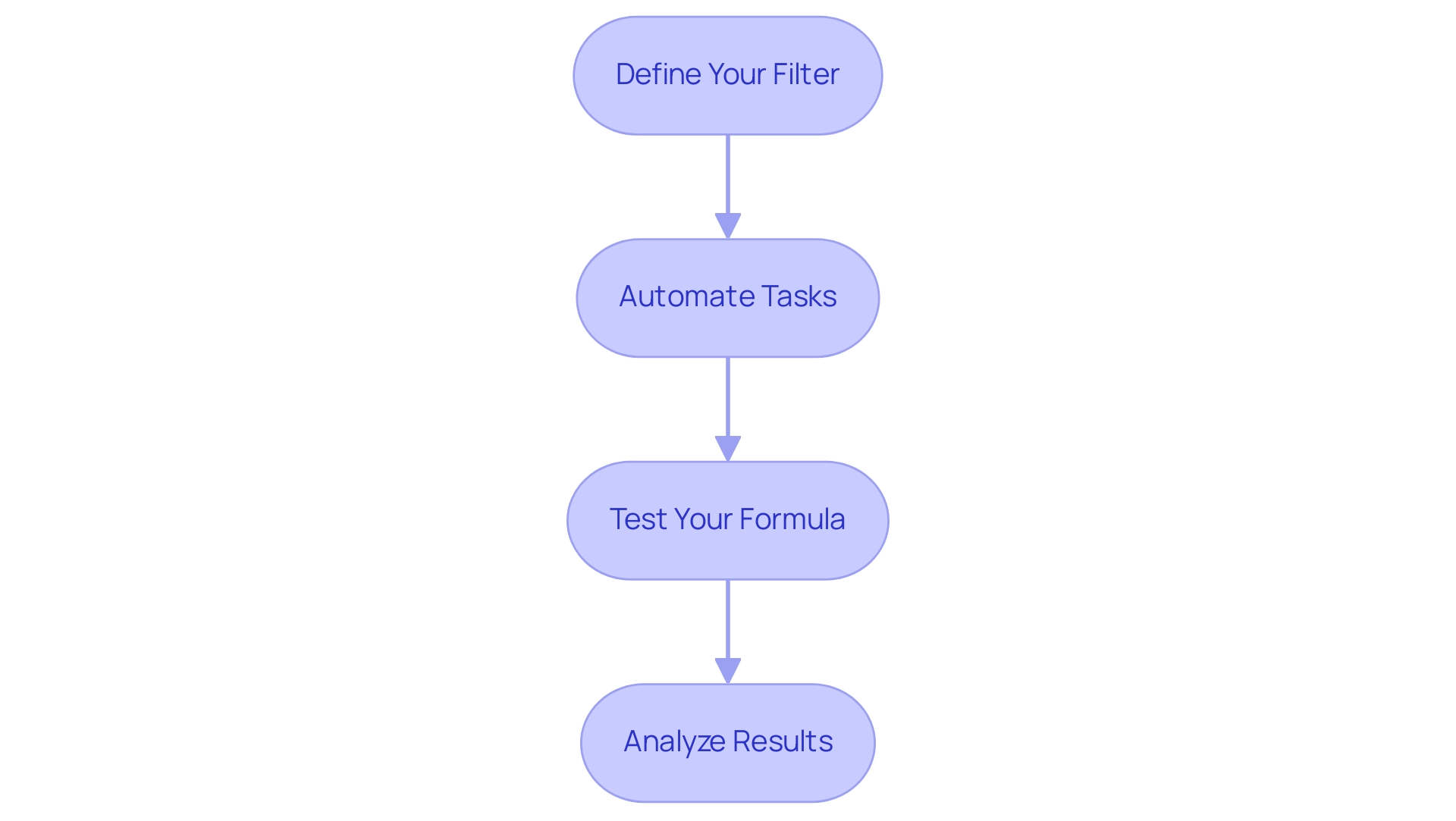
Performance Considerations for DISTINCTCOUNT in DAX
To enhance the performance of your DAX calculations when utilizing DISTINCTCOUNT, consider the following key strategies that align with Robotic Process Automation (RPA) principles, which can automate and streamline these processes:
-
Avoid Complex Filters: Implementing intricate filtering can significantly impede performance. Strive to simplify your filters wherever feasible to boost speed, mirroring the efficiency RPA brings to workflow automation. By automating the filtering process, RPA can ensure that only essential information is processed, enhancing overall performance.
-
Optimize Information Models: A well-structured information model is crucial. Proper optimization can lead to substantial improvements in DAX calculation performance, facilitating smoother operations. For instance, DAX Studio offers functionality to export and import VertiPaq model metadata using .vpax files, aiding in model optimization discussions and collaborations. RPA can automate the modeling process, ensuring consistent updates and optimizations without manual intervention.
-
Limit Size: When handling extensive datasets, employing dax distinctcount with filter to aggregate information can help minimize the number of rows processed, thereby enhancing efficiency—an approach that complements RPA’s capability to streamline workflows. RPA can automate the aggregation process, ensuring that only relevant data is analyzed, thus improving calculation speed.
-
Monitor Performance: Leverage tools like DAX Studio, which captures and formats Analysis Services traces, providing a user-friendly alternative to SQL Server Profiler. This tool enables you to analyze the performance of your DAX queries effectively and identify any bottlenecks. As Miguel Felix, a Super User, noted, “Can you share a sample file? I made a test file and it worked properly.” This highlights the importance of practical testing in optimizing performance, akin to testing RPA implementations for maximum effectiveness.
By implementing these performance optimization strategies in conjunction with RPA, users can not only unlock the full potential of their DAX calculations but also free up valuable team resources for more strategic, value-adding work. This dual approach leads to faster insights and more informed operational decision-making, helping navigate the complexities of the evolving AI landscape.
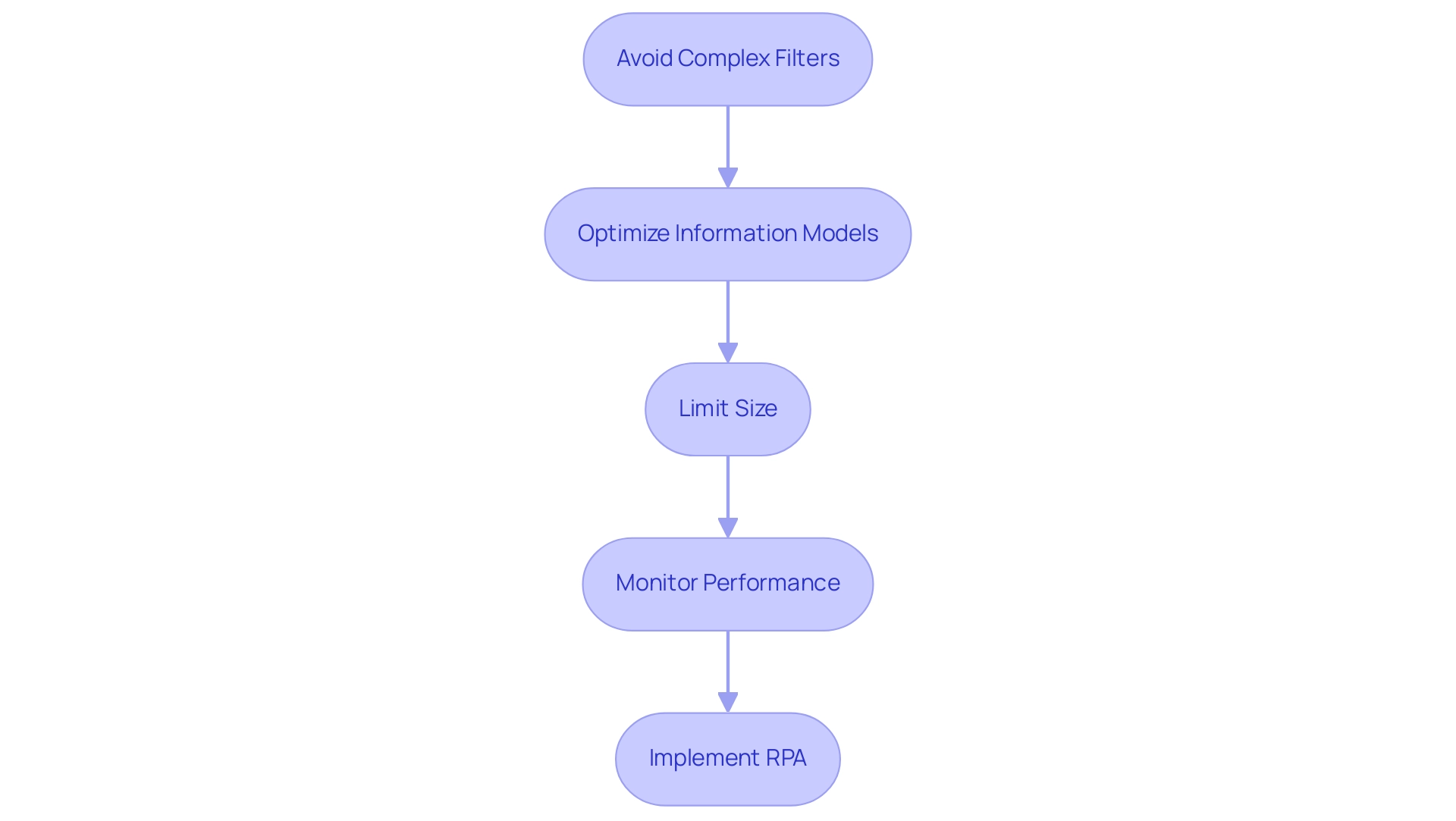
Conclusion
Harnessing the power of DAX functions like COUNTROWS and DISTINCTCOUNT is essential for any data analyst seeking to enhance operational efficiency and drive informed decision-making within their organization. These functions serve as critical tools in understanding dataset composition, whether through counting total entries or identifying unique values. By mastering these techniques, analysts can streamline their reporting processes and ensure data integrity, ultimately leading to more strategic insights.
The practical applications of DISTINCTCOUNT in various scenarios, such as assessing unique products sold or distinct customer interactions, illustrate its importance in contemporary data analysis. Coupled with Robotic Process Automation (RPA), these DAX functions can significantly reduce manual workloads and enhance data accuracy, allowing teams to focus on higher-value tasks. The integration of automation not only expedites data tasks but also ensures that insights remain timely and relevant.
As organizations continue to embrace data-driven strategies, the ability to effectively utilize DAX functions will be paramount. By implementing the discussed strategies and performance considerations, analysts can optimize their workflows and leverage insights that drive growth and innovation. The journey toward operational excellence begins with a solid understanding of these powerful tools, paving the way for data analysts to become key contributors to their organizations’ success.

